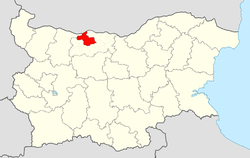Dolna Mitropoliya Municipality
Dolna Mitropoliya Municipality (Bulgarian: Община Долна Митрополия) is a municipality (obshtina) in Pleven Province, Northern Bulgaria. It embraces a territory of 674.81 km² with a population, as of December 2009, of 21,304 inhabitants.[1] The administrative centre of the area is the homonymous town of Dolna Mitropoliya.
Dolna Mitropoliya Municipality Община Долна Митрополия | |
|---|---|
Municipality | |
 Dolna Mitropoliya Municipality within Bulgaria and Pleven Province. | |
| Coordinates: 43°33′N 24°30′E | |
| Country | |
| Province (Oblast) | Pleven |
| Admin. centre (Obshtinski tsentar) | Dolna Mitropoliya |
| Area | |
| • Total | 674.81 km2 (260.55 sq mi) |
| Population (December 2009)[1] | |
| • Total | 21,304 |
| • Density | 32/km2 (82/sq mi) |
| Time zone | UTC+2 (EET) |
| • Summer (DST) | UTC+3 (EEST) |
The northern boundary of the municipality is the Danube River, and the 10,926 hectare Natura 2000 Reka Vit Special Protection Area for preservation of avian habitat is located there.[2]
Settlements
.png)
(towns are shown in bold):
| Town/Village | Cyrillic | Population[3][4][5] (December 2009) |
|---|---|---|
| Dolna Mitropoliya | Долна Митрополия | 3,303 |
| Baykal | Байкал | 562 |
| Bivolare | Биволаре | 627 |
| Bozhuritsa | Божурица | 1,102 |
| Bregare | Брегаре | 637 |
| Gorna Mitropoliya | Горна Митрополия | 1,827 |
| Gostilya | Гостиля | 279 |
| Komarevo | Комарево | 1,224 |
| Krushovene | Крушовене | 1,054 |
| Orehovitsa | Ореховица | 1,440 |
| Pobeda | Победа | 517 |
| Podem | Подем | 1,023 |
| Riben | Рибен | 769 |
| Slavovitsa | Славовица | 573 |
| Stavertsi | Ставерци | 1,848 |
| Trastenik | Тръстеник | 4,519 |
| Total | 21,304 |
Demography
The following table shows the change of the population during the last four decades. Since 1992 Dolna Mitropoliya Municipality has comprised the former municipality of Podem and the numbers in the table reflect this unification.
| Dolna Mitropoliya Municipality | ||||||||
|---|---|---|---|---|---|---|---|---|
| Year | 1975 | 1985 | 1992 | 2001 | 2005 | 2007 | 2009 | 2011 |
| Population | 28,405 | 24,079 | 29,087 | 25,311 | 22,994 | 22,237 | 21,304 | ... |
| Sources: Census 2001,[6] Census 2011,[7] „pop-stat.mashke.org“,[8] | ||||||||
Religion
According to the latest Bulgarian census of 2011, the religious composition, among those who answered the optional question on religious identification, was the following:
References
- (in English) Bulgarian National Statistical Institute - Bulgarian provinces and municipalities in 2009 Archived November 13, 2010, at the Wayback Machine
- Natura 2000 Bulgaria Database: Река Вит Archived November 8, 2006, at the Wayback Machine
- (in English) Bulgarian National Statistical Institute - Bulgarian towns in 2009 Archived November 13, 2010, at the Wayback Machine
- (in English) Bulgarian National Statistical Institute - Bulgarian villages under 1000 inhabitants - December 2009
- (in English) Bulgarian National Statistical Institute - Bulgarian Settlements 1000-5000 inhabitants - December 2009
- National Statistical Institute - Census 2001
- „pop-stat.mashke.org“
- "Population of Bulgarian divisions". Pop-stat.mashke.org. 2011-02-01. Retrieved 2012-03-28.
- "Religious composition of Bulgaria 2011". pop-stat.mashke.org.